Though the LSI SAS 9207-8i/e Host Bus Adapters have been around for a few years now, they are still the de facto standard for SAS2 solutions, which was immediately adapted when PCIe 3.0 was released. Since the inception of 6Gb/s SASs enabled HBAs and controllers, LSI has been its biggest proponent, having made incredibly successful devices since the beginning of the 9200 line. With these HBAs, LSI was a huge factor in pushing 6Gb/s into the mainstream.
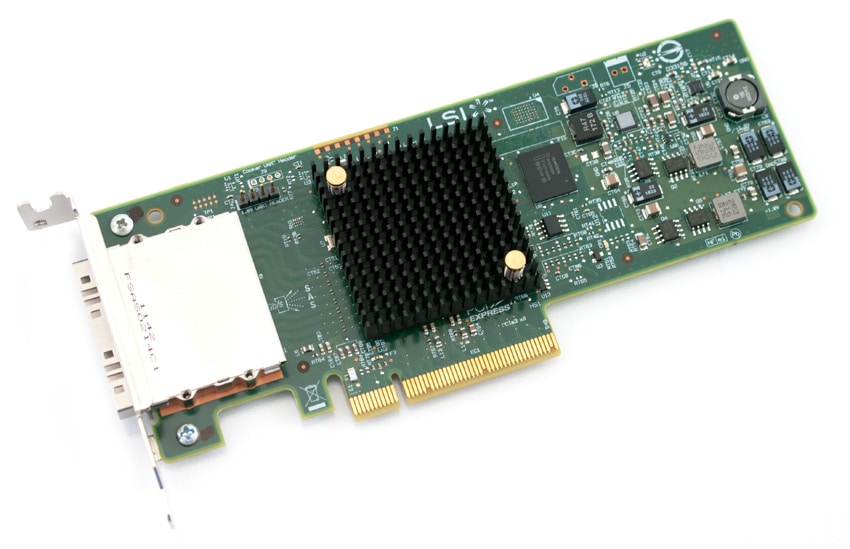
That said, the LSI SAS 9207-8i and 9207-8e are no exception to this fact due to its balance of affordability, performance, internal scalability. The LSI HBAs are designed for mid-range server storage applications, including tiered storage and backup and recovery with the 9207-8i’s ability to connect up to 256 SAS and SATA devices due to its 8 internal 6Gb/s SAS ports, while the 9207-8e supports up to 1024 SAS or SATA with its 8 external ports. Both the 8i and 8e are equipped with the LSISAS2308 6Gb/s SAS IO controller as well as a dual core 800MHz PowerPC processor.
As far as footprint goes, the LSI HBAs can fit into 1U/2U rack-mounted servers and workstations with low-profile form factor and supports all critical applications that use the bandwidth of PCIe 3.0 connectivity.
Specifications
- Model: LSI SAS 9207-8i (LSI00302)
- Contents: HBA, two Mini‐SAS to x4 SAS cables (CBL‐SAS8087OCF‐06M) & documentation CD
- Brackets: Full height and low profile
- Host Bus Type: x8 lane PCI Express 3.0
- Physical Dimensions: Low profile (2.6” x 6.6”)
- Internal Ports: 8
- Cable Support: Passive copper
- Data Transfer Rates: 6Gb/s SAS 2.1 compliant
- Devices Supported: 256 Non-RAID SAS/SATA devices
- OS Support: Microsoft Windows, Linux (SuSE , Red Hat), Solaris, VMware, FreeBSD
- Fusion MPT Support: Fusion MPT 2.0
- I/O Controller: LSI SAS2308
- Internal Connectors: 2 Mini-SAS SFF8087
- MTBF: >2,000,000 hours
- Operating Temperature: 0°C to 55°C
- Operating Humidity: 5% to 90% non-condensing
- Operating Voltage: +12V +/-8%; 3.3V +/-8%
- PCI Power: 9.8 W typical, Airflow 200 LFM
- Warranty: 3 years; with advanced replacement option
Design and build
As we mentioned above, the LSI SAS 9207-8i/e HBAs are low profile form factors that fits into any 1U and 2U server racks, offering 8 lanes of 6Gb/s SAS as well as 8 lanes of PCI Express 3.0 with 8Gb/s. The 9207 line looks noticeably different than the newer LSI models (such as the 93XX series) including a different shade of green as well as a different shape.
At the heart of the 9207-8i and 9207-8e lay the LSISAS2308 6Gb/s SAS controller, which is covered by a large heatsink. The LSI controller is embedded with PowerPC processors, which allows for a maximum host CPU offload and gives LSI the ability to publish a single binary OS driver to operate any Fusion MPT controller or adapter; a very attractive feature for businesses.
The 9207-8i’s two x4 internal SFF-8087 mini-SAS connectors (SFF8087) for its PCIe 3.0 interface are located at the edge end of the card, which provides SAS and SATA data transfer rates of 1.5, 3, and 6Gb/s per lane with the ability to reach over 650K IOPs. The 9207-8i can support up to 256 Non-RAID devices.
The 9207-8e is equipped with two (x4) external mini-SAS connectors (SFF8088) located at the front-left of the card, with the ability to also boast SAS and SATA data transfer rates of 1.5, 3, and 6Gb/s per lane at 650K IOPs. The 9207-8e can support up to 1024 Non-RAID devices.
Application Workload Analysis
In order to measure its performance during an application workload, we will look at the Toshiba HK3R2 review where the LSI SAS 9207-8i was leveraged. As you will see below, it certainly had an impressive showing.
Our MarkLogic NoSQL Database environment requires groups of four SSDs with a usable capacity of at least 200GB, since the NoSQL database requires roughly 650GB of space for its four database nodes. Our protocol uses an SCST host and presents each SSD in JBOD, with one allocated per database node. The test repeats itself over 24 intervals, requiring between 30-36 hours total. MarkLogic records total average latency as well as interval latency for each SSD.
In our overall average latency tests using our MarkLogic NoSQL database benchmark, the HK3R2 posted a class-leading 2.122ms in overall average latency when using the 9207-8i.
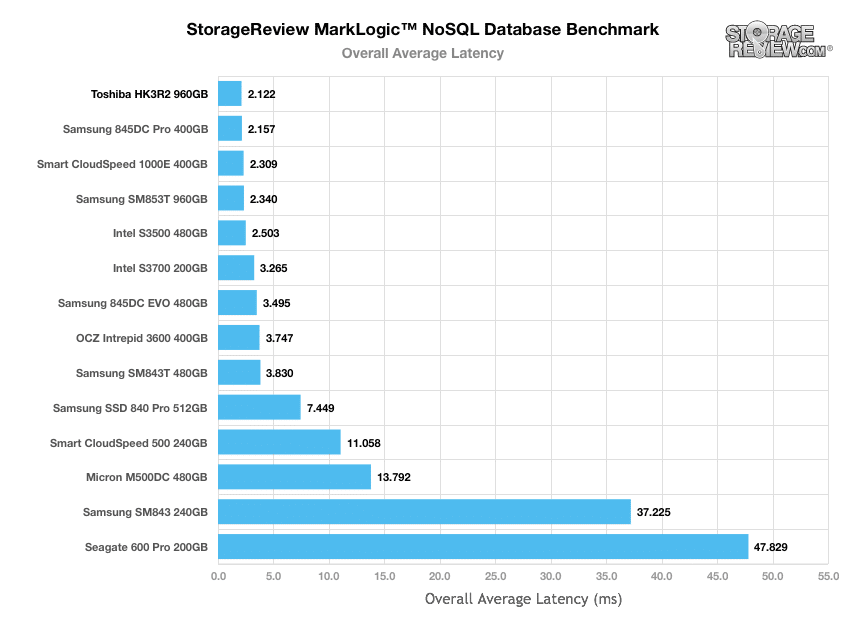
The next application benchmark consists of a Percona MySQL OLTP database measured via SysBench. In this configuration, we used a group of Lenovo ThinkServer RD630s as database clients and the database environment stored on a single drive. For this review, we will only look at its performance during Average Transactions Per Second (TPS).
Leveraging the 9207-8i HBA, the Toshiba HK3R2 SSD continued its best-in-class performance, as it reached almost 1,700TPS. These results made it the clear winner amongst its comparables.
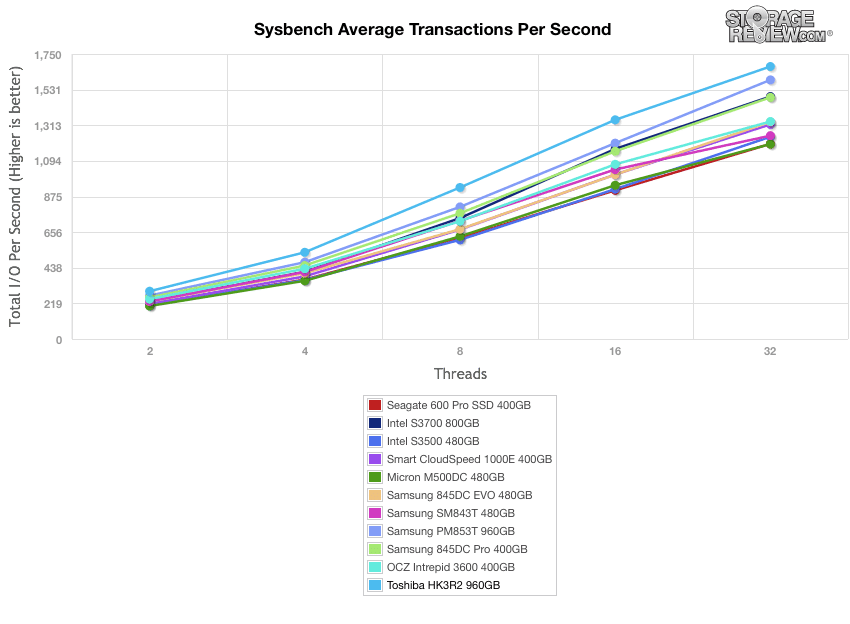
StorageReview’s Microsoft SQL Server OLTP testing protocol employs the current draft of the Transaction Processing Performance Council’s Benchmark C (TPC-C), an online transaction processing benchmark that simulates the activities found in complex application environments. The TPC-C benchmark comes closer than synthetic performance benchmarks to gauging the performance strengths and bottlenecks of storage infrastructure in database environments. Our SQL Server protocol uses a 685GB (3,000 scale) SQL Server database. We will be looking at its performance in latency with a 30,000 VU Load.
Here, the Toshiba HK3R2 boasted an impressive 12.0ms (tieing the Samsung 845DC Pro) for the best overall average latency.
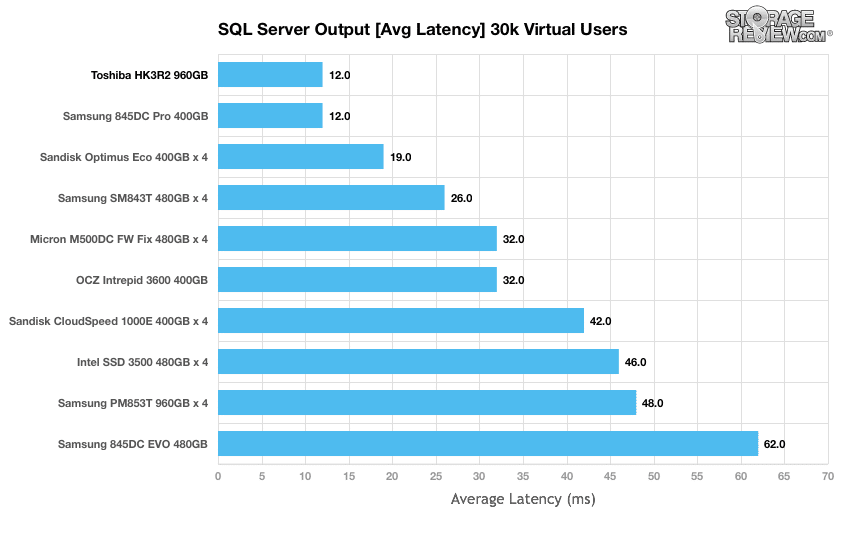
Enterprise Synthetic Workload Analysis
To measure the Enterprise Synthetic performance of the LSI SAS 9207-8i/e HBA, we will reference the iXsystems Titan 316J JBOD storage expansion shelf where it was used with the following drives:
- Toshiba MK01GRRB (147GB, 15,000RPM, 6.0Gb/s SAS)
- Toshiba MBF2600RC (600GB, 10,000RPM, 6.0Gb/s SAS)
- Hitachi Ultrastar 7K4000 (4TB, 7,200RPM, 6.0Gb/s SATA)
The enterprise testing platform was based on a Lenovo ThinkServer RD630. The ThinkServer RD630 is configured with:
- 2 x Intel Xeon E5-2620 (2.0GHz, 15MB Cache)
- Windows Server 2008 R2 SP1 64-Bit, Windows Server 2012 64-Bit, and CentOS 6.3 64-Bit
- Intel C602 Chipset
- Memory – 16GB (2 x 8GB) 1333Mhz DDR3 Registered RDIMMs
- LSI 9207 SAS/SATA 6.0Gb/s HBA
Our enterprise storage benchmark process begins with an analysis of the way the drive performs during a thorough preconditioning phase. Each of the comparable hard drive arrays are setup in RAID10, allowed to fully sync, and then tested under a heavy load of 16 threads with an outstanding queue of 16 per thread down to our light load of 2 threads with an outstanding queue of 2 per thread.
We will be looking at two of the six Enterprise Synthetic Workload Analyses that were tested:
- Sequential
- 8K
- 100% Read or 100% Write
- 100% 8K
- 128K
- 100% Read or 100% Write
- 100% 128K
- 8K
In 8K sequential read and write performance, both spindle speed and areal density are utilized. Here, the 7,200RPM Hitachi Ultrastar 7K4000 RAID10 offered the fastest 8K read speed, measuring 911MB/s (82MB/s write), while the Toshiba 15K RAID10 measured 811MB/s (186MB/s write), and the Toshiba 10K RAID10 measured 612MB/s (178MB/s write).
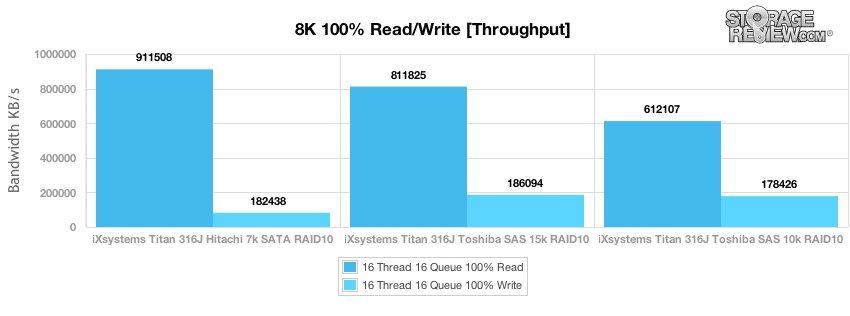
Our next sequential test measured large-block transfer speeds. In this workload profile leveraging the LSI SAS 9207-8i/e HBA, the 15K SAS array measured 1,535MB/s read and 839MB/s write, while the 7.2K SATA array recorded 1,361MB/s read and 912MB/s write, and the 10K SAS array with 1,142MB/s read and 540MB/s write.
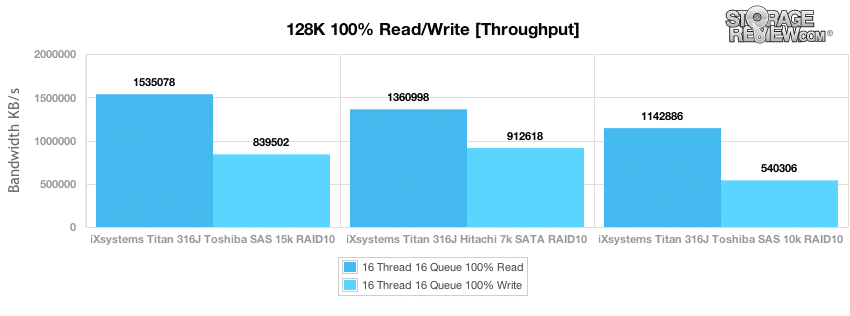
Conclusion
The LSI SAS 9207 HBAs bring an impressive SAS2 RAID solution for enterprises with high-end storage servers, especially for those who are looking for a balance of affordability, performance, scalability as well as the given reliability of LSI. Designed for mid-range server storage applications including tiered storage and backup and recovery, the 9207-8i connects up to 256 SAS and SATA devices with its 8 internal 6Gb/s SAS ports, while the 9207-8e supports up to 1024 SAS or SATA with its 8 external ports; however, they must be non-RAID devices
Overall, the 9207 series are both extremely stable and performance driven. The equipped LSISAS2308 6Gb/s SAS IO controller, as well as its dual core 800MHz PowerPC processor, allow these HBAs to boast this impressive performance. This was certainly evident in virtually every application we leveraged the LSI HBAs, such as very low latency and very high throughput with the iXsystems Titan 316J JBOD storage expansion and the Toshiba HK3R2 SSD as demonstrated above. For example, the Toshiba drive posted the best MarkLogic NoSQL database benchmark we had seen to date, boasting over 2.122ms across 32 threads while almost reaching 1,700TPS across 32 threads in our MySQL benchmark.
Overall, these LSI HBAs are hard to beat when it comes to SAS2 technology though SAS3 users should look at the LSI 9300 series.
Bottom Line
LSI SAS 9207-8i/e are an impressive series of HBAs with balance of affordability, performance, scalability all the while providing enterprises with an ideal solution for high-end storage servers.




 Amazon
Amazon